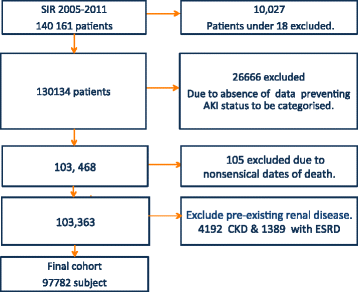Evolution of chronic renal impairment and long-term mortality after de novo acute kidney injury in the critically ill; a Swedish multi-centre cohort study
- PMID: 25944032
- PMCID: PMC4457200
- DOI: 10.1186/s13054-015-0920-y
Evolution of chronic renal impairment and long-term mortality after de novo acute kidney injury in the critically ill; a Swedish multi-centre cohort study
Abstract
Introduction: Acute Kidney Injury (AKI) is common in critical ill populations and its association with high short-term mortality is well established. However, long-term risks of death and renal dysfunction are poorly understood and few studies exclude patients with pre-existing renal disease, meaning outcome for de novo AKI has been difficult to elicit. We aimed to compare the long-term risk of Chronic Kidney Disease (CKD), End Stage Renal Disease (ESRD) and mortality in critically ill patients with and without severe de novo AKI.
Method: This cohort study was conducted between 2005 and 2011 in Swedish intensive care units (ICU). Data from 130134 adult patients listed on the Swedish intensive care register-database was linked with other national registries. Patients with pre-existing CKD (4192) and ESRD (1389) were excluded, as were cases (26771) with incomplete data. Patients were classified according to AKI exposure during ICU admission. Outcome in the de novo AKI group was compared to the non-exposed (no-AKI) intensive care control group. Primary outcome was all-cause mortality. Follow-up ranged from one to seven years (median 2.1 years). Secondary outcomes were incidence of CKD and ESRD and median follow-up was 1.3 years.
Results: Of 97 782 patients, 5273 (5.4%) had de novo AKI. These patients had significantly higher crude mortality at one (48.4% vs. 24.6%) and five years (61.8% vs. 39.1%) compared to the control group. The first 30% of deaths in AKI patients occurred within 11 days of ICU admission whilst the 30-centile in the no-AKI group died by 748 days. CKD was significantly more common in AKI survivors at one year (6.0% vs. 0.44%) than in no-AKI group (adjusted incidence rate ratio (IRR) 7.6). AKI patients also had significantly higher rates of ESRD at one (2.0% vs. 0.08%) and at five years (3.9% vs. 0.3%) than those in the comparison group (adjusted IRR 22.5).
Conclusion: This large cohort study demonstrated that de novo AKI is associated with increased short and long-term risk of death. AKI is independently associated with increased risk of CKD and ESRD as compared to an ICU control population. Severe de novo AKI survivors should be routinely followed-up and their renal function monitored.
Figures


References
Publication types
MeSH terms
LinkOut - more resources
Full Text Sources
Other Literature Sources
Medical

